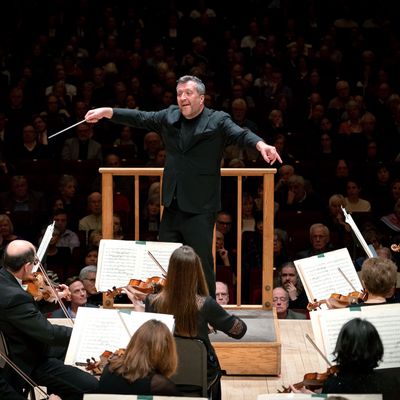
By rights, the concerto, with its heroic dazzle and one-versus-many rhetoric, should by now be occupying the same upper shelf as the epic poem and the masque. What does the virtuoso vehicle have to say to our skeptical, networked world? The genre depends on the audience rooting for the solo swashbuckler, as portrayed by a violin’s aerobatics or a piano’s cataracts of scales. Today, though, outsize nonconformists are regularly revealed as entitled whiners, con men, and predators, their sagas sung only on Twitter. What heroic principle is left for a composer to lionize?
And yet the concerto has outlived innumerable styles and eras, because its basic asymmetry — one or several soloists front and center; orchestra fanning out behind — adapts to any cultural moment and any combination of instruments and electronics. (Yo-Yo Ma and Wu Man recently performed Zhao Lin’s A Happy Excursion, Concerto for Cello and Pipa, with the New York Philharmonic.) Now the composer Thomas Adès has produced what he calls a “proper piano concerto,” an action-packed throwback to brass-knuckle showpieces by Rachmaninoff, Tchaikovsky and other Russians of yore. To drive the similarity home, when he conducted Kirill Gerstein and the Boston Symphony Orchestra’s New York premiere of the work at Carnegie Hall, he wrapped up the evening with a scorching performance of Tchaikovsky’s Symphony No. 4.
Adès treats the history of Western music like a bottomless costume trunk that he can mine for any disguise. He reaches in and emerges with bits of Couperin, Nancarrow, club rhythms, baroque canons, mixing them up and matching them to his own expressive purpose. So when Kirill Gerstein and the BSO tore into the new concerto, and the syncopated outline of Gershwin’s “I Got Rhythm” came rocketing out of the orchestra, all warbly and percussive, like an underwater cannon shot, I figured Adès was trying on another wig and mustache, ready for a new romp.
The Gershwin echo is just a retro come-on, it turns out, for a work that proves at once familiar and spectacularly fresh. Adès steers listeners through a dense urban landscape, pointing out recognizable landmarks and glimpses of fantastic spectacle, the timbres shifting like shadows. The slow second movement opens with a dark brass-and-winds choir, which falls away as soon as the piano wafts dreamily into the frame, a melancholy motif on a cloud of pungent chords. By movement’s end, the piano has sunk quietly into tuba range, and the fade to midnight blue sets up the next scene, a jangly explosion of saturated colors, like opening a door on a wild basement party. The piano jitters, and the clarinet goes rocketing out the window, leaving glissando contrails. A juddering marimba hands off to chattering brass, which trip over each other’s syncopations. Does any living composer organize delirium with as much finesse and flair as Adès? He’s the Mad Max of composers.
He doesn’t make things easy, for either pianist or audience, which is part of his music’s pleasure. Gerstein clearly relishes the high-speed stunts and swerves, the big-hand power chords, and the spumes of notes spraying from the keyboard. Intricate bursts of sound come at the listener in dizzying 3-D, but the drama is always clear and the momentum thrilling, and the audience at Carnegie Hall responded to the music’s complexity with a simple, spontaneous roar.


